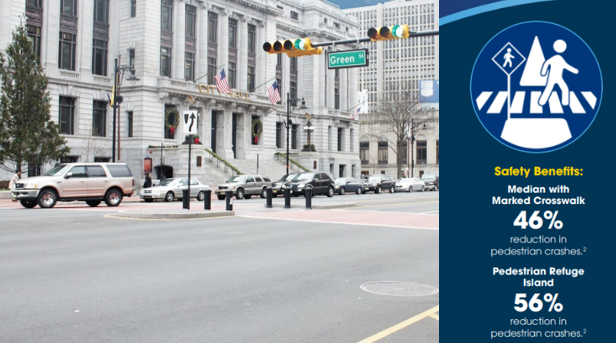Pedestrians and bicyclists now account for 34 percent of all severe and fatal traffic injuries in New Jersey (New Jersey State Police, 2020). The New Jersey State Police report a 9-percent increase in serious injuries in 2020 compared to 2019. Providing safer streets does not depend on just one action but on implementing several strategies that respond to road conditions and the needs of different road users. Through the State’s Complete Streets efforts, the Strategic Highway Safety Plan, and the Driving Towards Zero Deaths initiative, authorities in New Jersey have continued to demonstrate that ensuring safety for all road users and reducing pedestrian, bicycle, and vehicle fatalities is a top priority.
The Federal Highway Administration’s (FHWA) Proven Safety Countermeasures initiative (PSCi) is a collection of countermeasures and strategies that are effective in reducing roadway fatalities and serious injuries on our nation’s roadways. This first part of a three-part series dedicated to FHWA’s Proven Safety Countermeasures will highlight several countermeasures that the New Jersey Department of Transportation (NJDOT) promotes as ways to accelerate the achievement of local, state, and national safety goals through training and educational videos.
FHWA’s PSCi is comprised of 28 actions that transportation agencies can use on local, state, and federal roads to reduce the number of fatalities and severe injuries among road users. The measures provide a guide to what could be implemented along the roadway and at crossings with road design, speed reinforcement, and warning signals. NJDOT promotes many of these countermeasures to improve safety for pedestrians and bicyclists through a series of videos, which are highlighted below.

A Leading Pedestrian Interval (LPI) is a low-cost measure that prioritizes pedestrians in intersections, allowing them between 3 and 7 seconds to enter a marked crosswalk at an intersection before any vehicles are given a green light. This reduces conflicts between pedestrians and vehicles, improves pedestrian visibility, and increases the probability of motorists yielding. Giving vulnerable users a head start can reduce pedestrian-vehicle crashes at intersections by 13 percent [1].

A Walkway is any type of defined space or pathway for use by a person traveling by foot or using a wheelchair and includes pedestrian walkways, shared use paths, sidewalks, or roadway shoulders. The use of sidewalks can reduce the risk of crashes involving pedestrians walking along roadways by between 65 and 89 percent, and even paved shoulders can reduce the risk these types of crashes by 71 percent [2].
Pedestrian Crossing Islands located within roadway medians provide a safe space for vulnerable users to stop at the midpoint of the roadway before crossing the remaining distance. Refuges should be considered especially in mid-block crossings and in multilane intersections with intermediate or high travel speeds. Pedestrian refuge islands can reduce pedestrian crashes by 56 percent [3].

A Pedestrian Hybrid Beacon is a traffic control device that helps pedestrians safely cross at mid-block and uncontrolled intersections on higher-speed roads. The beacon remains dark until a pedestrian pushes the button to activate it, which then initiates a yellow to red lighting sequence consisting of flashing and steady lights that direct motorists to slow and come to a stop. This provides the right-of-way to the pedestrian to safely cross. This countermeasure can result in a 55 percent reduction in pedestrian crashes, a 29 percent reduction in total crashes, and a 15 percent reduction in fatal and serious injury crashes [4].

A Road Diet is a reallocation of roadway space that reduces the total lanes for vehicles. Road diets result in fewer lanes for pedestrians to cross, increased space for refuge islands or bicycle lanes, and a more community-focused, Complete Streets environment that better accommodates the needs of all road users. This type of reconfiguration has shown a between 19- and 47-percent reduction in total crashes [5].
NJDOT’s videos highlight how FHWA’s Proven Safety Countermeasures have been shown to reduce both the occurrence and severity of crashes. However, the recommendations are not limited to those discussed here. The FHWA continues to evaluate additional countermeasures, and a full list of those already identified can be viewed on their website.
References
https://www.njdottechtransfer.net/2019/09/27/njdot-safety-countermeasures-videos/
https://safety.fhwa.dot.gov/provencountermeasures/
https://www.nj.com/news/2021/12/pedestrian-deaths-in-nj-on-track-to-hit-30-year-high-we-need-solutions-advocates-say.html
[1] https://www.njdottechtransfer.net/2019/09/27/njdot-safety-countermeasures-videos/
[2] https://safety.fhwa.dot.gov/provencountermeasures/walkways.cfm
[3] https://safety.fhwa.dot.gov/provencountermeasures/ped_medians.cfm
[4] https://safety.fhwa.dot.gov/provencountermeasures/ped_hybrid_beacon.cfm
[5] https://safety.fhwa.dot.gov/provencountermeasures/road_diets.cfm

